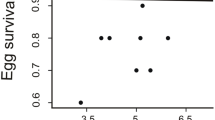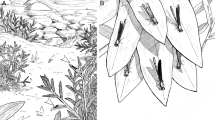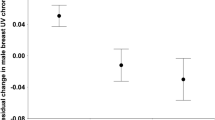Abstract
The theory of sexual selection was developed to explain the evolution of highly exaggerated sexual ornaments1. Now supported by vast empirical evidence2, sexual selection is generally considered to favour individuals with the most extreme trait expression2,3,4. Here we describe disruptive selection on a sexual ornament, plumage coloration, in yearling male lazuli buntings (Passerina amoena). In habitats with limited good-quality nesting cover, the dullest and the brightest yearlings were more successful in obtaining high-quality territories, pairing with females and siring offspring, than yearlings with intermediate plumage. This pattern reflects the way that territorial adult males vary levels of aggression to influence the structure of their social neighbourhood. Adult males showed less aggression towards dull yearlings than intermediate and bright ones, permitting the dull yearlings to settle on good territories nearby. Fitness comparisons based on paternity analyses showed that both the adults and dull yearlings benefited genetically from this arrangement, revealing a rare example of sexually selected male–male cooperation5,6.
This is a preview of subscription content, access via your institution
Access options
Subscribe to this journal
Receive 51 print issues and online access
$199.00 per year
only $3.90 per issue
Buy this article
- Purchase on Springer Link
- Instant access to full article PDF
Prices may be subject to local taxes which are calculated during checkout




Similar content being viewed by others
References
Darwin, C. The Descent of Man, and Selection in Relation to Sex (Murray, London, 1881).
Andersson, M. Sexual Selection (Princeton Univ. Press, Princeton, 1994).
Lande, R. Models of speciation by sexual selection on polygenic traits. Proc. Natl Acad. Sci. USA 78, 3721– 3725 (1981).
Endler, J. A. Natural Selection in the Wild (Princeton Univ. Press, Princeton, 1986).
McDonald, D. B. & Potts, W. K. Cooperative display and relatedness among males in a lek-mating bird. Science 266, 1030–1032 (1994).
Noë, R. & Hammerstein, P. Biological markets: supply and demand determine the effect of partner choice in cooperation, mutualism and mating. Behav. Ecol. Sociobiol. 35, 1– 11 (1994).
Greene, E., Muehter, V. R. & Davison, W. in Birds of North America (eds Poole, A. & Gill, F.) No. 232 (The Academy of Natural Sciences, Philadelphia & The American Ornithologists’ Union, Washington DC, 1996 ).
Price, T. D. Sexual selection on body size, territory and plumage variables in a population of Darwin's Finches. Evolution 38, 327– 341 (1984).
Muehter, V. M., Greene, E. & Ratcliffe, L. Delayed plumage maturation in Lazuli buntings: tests of the female mimicry and status signalling hypotheses. Behav. Ecol. Sociobiol. 41, 281–290 (1997).
Rohwer, S., Fretwell, S. D. & Niles, D. M. Delayed plumage maturation and the deceptive acquisition of resources. Am. Nat. 115, 400– 437 (1980).
Lyon, B. E. & Montgomerie, R. D. Delayed plumage maturation in passerine birds: reliable signaling by subordinate males? Evolution 40, 605–615 ( 1986).
Schluter, D. Estimating the form of natural selection on a quantitative trait. Evolution 42, 849–861 ( 1988).
Smith, T. B. Disruptive selection and the genetic basis of bill size polymorphism in the African finch Pyrenestes ostrinus. Nature 363 , 618–620 (1993).
Gross, M. R. Disruptive selection for alternative life history strategies in salmon. Nature 313, 47–48 ( 1985).
Sappington, T. W. & Taylor, O. R. Disruptive sexual selection in Colias eurytheme butterflies. Proc. Natl Acad. Sci. USA 87, 6132–6135 ( 1990).
Morton, E. S., Forman, L. & Braun, M. Extra-pair fertilizations and the evolution of colonial breeding in purple martins. Auk 107, 275 –283 (1990).
Møller, A. P. & Birkhead, T. The evolution of plumage brightness in birds is related to extra-pair paternity. Evolution 48, 1089–1100 (1994).
Yezerinac, S. M. & Weatherhead, P. J. Extra-pair mating, male plumage coloration and sexual selection in yellow warblers ( Dendroica petechia). Proc. R. Soc. Lond. B 264, 527–532 (1997).
Dugatkin, L. A. & Sargent, R. C. Male-male association patterns and female proximity in the guppy, Poecilia reticulata. Behav. Ecol. Sociobiol. 35, 141–145 (1994).
Wagner, R. H. The pursuit of extra-pair copulations by female birds: a new hypothesis of colony formation. J. Theor. Biol. 163, 333 –346 (1993).
Gibbs, H. L. et al. Realized reproductive success of polygynous red-winged blackbirds revealed by DNA markers. Science 250, 1394 –1397 (1990).
Rohwer, S. & Butcher, G. S. Winter versus summer explanations of delayed plumage maturation in temperate passerine birds. Am. Nat. 131, 556–572 ( 1988).
Orians, G. H. On the evolution of mating systems in birds and mammals. Am. Nat. 103, 589–603 ( 1969).
Emlen, S. T. & Oring, L. W. Ecology, sexual selection and the evolution of animal mating systems. Science 197, 215–223 (1977).
Birkhead, T. R. & Møller, A. P. Sperm Competition in Birds: Evolutionary Causes and Consequences (Academic, London, 1992).
Davies, N. B. Sexual conflict and the polygamy threshold. Anim. Behav. 38, 226–234 (1989).
Young, B. E. Annual molts and interruption of the fall migration for molting in Lazuli buntings. Condor 93, 236– 250 (1991).
Hunt, S., Bennett, A., Cuthill, I. & Griffith, R. Blue tits are ultraviolet tits. Proc. R. Soc. Lond. B 265, 451–455 (1998).
Lessells, C. M. & Boag, P. T. Unrepeatable repeatabilities: a common mistake. Auk 104, 116– 121 (1987).
Otter, K., Ratcliffe, L., Michaud, D. & Boag, P. T. Do female black-capped chickadees prefer high-ranking males as extra-pair partners? Behav. Ecol. Sociobiol. 43, 25 –36 (1998).
Acknowledgements
S. Cosh and T. Rooneem ran the DNA fingerprinting. We thank A. Keyser and G. Hill for assistance in measuring reflectance of bunting plumage, and J. Elliott and B. Sinervo for assistance with the splines. We thank K. Bright, A. Chaine, K. Dial, D. Emlen, A. Greene, J. Jolivette, R. Hutto, S. Jones, R. Montgomerie, H. Powell, K. Short, B. Sinervo, B. Walker and K. Wasson for comments on the manuscript. We were assisted in the field by A. Agather, J. Carlson, W. Davison, R. Domenech, A. Edmonds, K. Grey, D. Gryskiewicz, J. Haskell, Q. Hodgson, K. Horst, K. Karwacky, L. Keeton, A.M. Lareau, J. Laws, J. Lee, L. Leroux, J. Lloyd, N. Marlenee, M. Miller, C. Minch, M. Miyai, A. Rapone, T. Redman, C. Richardson, J. Roach, J. Root, R. Sacco, R. Scholl, Y. Tamanda, A. Tomon, L. Whitney, B. Winter, K. Wood and J. York. This research was supported by the US Fish and Wildlife Service (to E.G.), Kananaskis Field Stations, University of Calgary (to B.E.L.), NSERC Collabourative Grant and NSERC Research Grants (to L.R. and P.T.B.), and an Ontario Graduate Scholarship, Queen's University School of Graduate Studies, American Museum of Natural History, Sigma Xi, Society of Canadian Ornithologists (to V.R.M.).
Author information
Authors and Affiliations
Corresponding author
Rights and permissions
About this article
Cite this article
Greene, E., Lyon, B., Muehter, V. et al. Disruptive sexual selection for plumage coloration in a passerine bird . Nature 407, 1000–1003 (2000). https://doi.org/10.1038/35039500
Received:
Accepted:
Issue Date:
DOI: https://doi.org/10.1038/35039500
This article is cited by
-
Individual Movement Strategies Revealed through Novel Clustering of Emergent Movement Patterns
Scientific Reports (2017)
-
Delayed plumage maturation in birds and the significance of condition-dependent parental care
Behavioral Ecology and Sociobiology (2015)
-
Direct mate choice for simultaneous acoustic and visual courtship displays in the damselfish, Dascyllus albisella (Pomacentridae)
Environmental Biology of Fishes (2013)
-
Facing Uncertainty: How Small Songbirds Acquire and Use Social Information in Habitat Selection Process?
Springer Science Reviews (2013)
-
Delayed maturation of multiple signals in a migratory songbird
Behavioral Ecology and Sociobiology (2012)
Comments
By submitting a comment you agree to abide by our Terms and Community Guidelines. If you find something abusive or that does not comply with our terms or guidelines please flag it as inappropriate.



